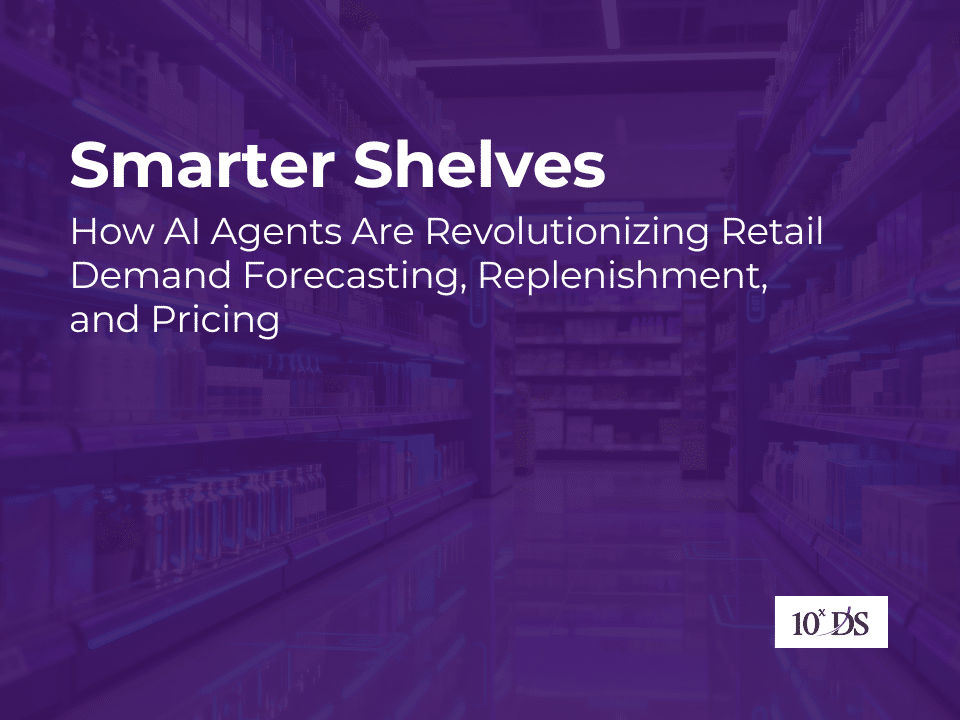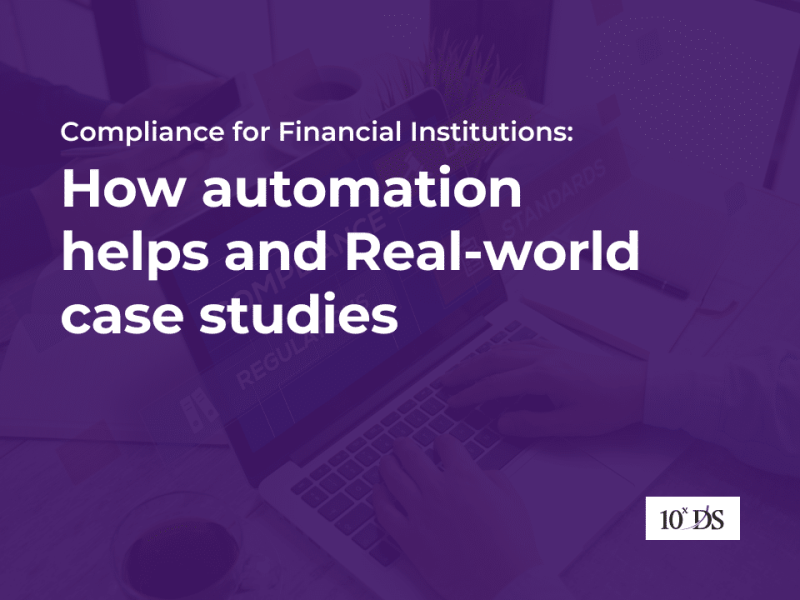
Smarter Shelves: How AI Agents Are Revolutionizing Retail Demand Forecasting, Replenishment, and Pricing
In today’s fast-paced retail environment, the ability to anticipate customer demand, replenish inventory efficiently, and adjust prices dynamically, is a necessity. With fluctuating consumer behaviour, supply chain disruptions, and competitive pricing pressures, retailers are turning to AI agents for demand forecasting and replenishment to stay ahead. These intelligent systems are transforming how retailers manage stock, reduce waste, and improve customer satisfaction.
Tackling the Retail Inventory Challenge with AI-Driven Forecasting and Replenishment
Retailers have struggled for a long time with balancing inventory levels. Overstocking leads to increased holding costs and markdowns, while understocking results in missed sales and dissatisfied customers. Traditional forecasting methods—often reliant on historical sales data and manual spreadsheets—fall short in capturing real-time market dynamics.
Enter AI agents for demand forecasting: autonomous systems that analyse vast datasets, including sales trends, weather patterns, promotions, and even social media sentiment, to predict future demand with remarkable accuracy. When paired with AI agents for demand replenishment, these forecasts are instantly translated into actionable decisions—automatically triggering restocking orders, adjusting warehouse allocations, and optimizing delivery schedules.
How AI Agents Work: A Technical Overview
AI agents operate as autonomous decision-makers within a multi-agent system. Each agent is designed to perform a specific task—such as forecasting demand for a product category or managing replenishment for a store location. These agents communicate with each other, share insights, and adapt their strategies based on real-time data.
For example, a forecasting agent might detect a spike in demand for umbrellas due to an upcoming storm. It alerts the replenishment agent, which then checks current inventory levels, supplier lead times, and logistics constraints before placing an optimized order. This coordination reduces human error, speeds up response times, and ensures shelves are stocked precisely when needed.
Inventory Management: Precision at Scale
Inventory management is one of the most critical areas where AI agents deliver value. Traditional systems often rely on static rules and periodic reviews, which can’t keep up with the dynamic nature of retail. AI agents, however, continuously monitor inventory levels, sales velocity, and external factors to make real-time decisions.
Key capabilities include:
- Automated Stock Level Monitoring: AI agents track inventory across multiple locations and flag potential shortages or surpluses.
- Smart Reordering: Based on predictive analytics, replenishment agents place orders before stockouts occur, factoring in supplier lead times and demand variability.
- Warehouse Optimization: AI agents help allocate inventory across distribution centres to minimize shipping costs and delivery times.
- Shelf-Level Intelligence: Edge AI agents deployed in stores can adjust stock displays based on local demand and foot traffic.
AI driven methodologies are revolutionizing inventory management by addressing the complexities of modern supply chains. By analysing fluctuating stock parameters—such as demand variability, lead times, and supplier performance—AI enables systems that are not only more adaptive and predictive but also significantly more efficient. AI and machine learning (ML) can be strategically applied to optimize stock levels, reduce holding costs, and enhance overall supply chain responsiveness through intelligent automation and data-driven decision-making.
Dynamic Pricing: Real-Time Revenue Optimization
Dynamic pricing is another area where AI agents are making a significant impact. Pricing agents analyse competitor prices, demand elasticity, inventory levels, and customer behaviour to adjust prices in real time. This ensures retailers remain competitive while maximizing margins.
For example:
- High-demand products may see price increases during peak seasons.
- Slow-moving inventory can be discounted to accelerate turnover.
- Localized pricing allows retailers to tailor prices based on regional demand and purchasing power.
In essence, AI-powered dynamic pricing empowers retailers to respond instantly to market shifts, optimize revenue streams, and maintain a competitive edge—all while aligning pricing strategies with real-time consumer and inventory insights.
Business Benefits: Efficiency, Accuracy, and Agility
The adoption of AI agents for Demand Replenishment offers several tangible benefits:
- Reduced Stockouts and Overstocks: AI agents continuously monitor sales and inventory data, adjusting replenishment schedules dynamically.
- Improved Forecast Accuracy: Machine learning models learn from past performance and external variables, refining predictions over time.
- Operational Efficiency: Automation reduces manual workload, freeing staff to focus on strategic tasks.
- Cost Savings: Optimized inventory levels minimize waste and reduce storage costs.
- Customer Satisfaction: Products are available when and where customers want them, improving loyalty and brand perception.
Technical Implementation: What’s Under the Hood?
Implementing AI agents requires a robust technical foundation. Here are some key components:
1. Data Infrastructure
AI agents rely on high-quality, real-time data. Retailers must integrate data from point-of-sale systems, e-commerce platforms, supply chain databases, and external sources like weather APIs and social media feeds.
2. Machine Learning Models
Forecasting agents typically use time-series models, neural networks, or ensemble methods to predict demand. These models are trained on historical data and continuously updated as new data flows in.
3. Agent Communication Protocols
Multi-agent systems require standardized protocols for agents to share information and coordinate actions. Technologies like REST APIs, message queues, and agent-based modelling frameworks are commonly used.
4. Cloud and Edge Computing
To ensure scalability and responsiveness, AI agents often operate in cloud environments, with edge computing used for real-time decision-making at store level.
5. Security and Governance
Retailers must ensure data privacy, compliance with regulations (like GDPR), and robust cybersecurity measures to protect sensitive information.
Strategic Considerations for Retailers
While the technology is powerful, successful deployment depends on strategic alignment. Retailers should consider the following:
- Start Small, Scale Fast: Begin with pilot projects in select categories or regions, then expand based on results.
- Cross-Functional Collaboration: Involve IT, supply chain, merchandising, and store operations teams to ensure holistic implementation.
- Vendor Partnerships: Collaborate with AI solution providers who understand retail nuances. Various platforms offer tailored solutions for demand forecasting and replenishment.
- Continuous Learning: AI agents improve over time. Retailers must commit to ongoing model training, performance monitoring, and system updates.
The Human Element: Augmenting, Not Replacing
It’s important to note that AI agents are not replacing retail professionals—they’re augmenting their capabilities. Store managers, supply chain analysts, and merchandisers still play a critical role in interpreting insights, setting strategic direction, and handling exceptions.
By automating routine tasks and surfacing actionable insights, AI agents empower teams to focus on higher-value activities, such as customer engagement, innovation, and long-term planning.
Real-World Applications: AI in Action
Several retailers are already reaping the rewards of AI-powered demand management:
- Walmart uses AI agents to analyse customer behaviour and automate replenishment across thousands of stores.
- Zara leverages predictive analytics to adjust inventory based on fashion trends and regional preferences.
- Amazon employs machine learning to forecast demand and manage its vast fulfilment network with precision.
These examples highlight how AI agents for Demand Forecasting and replenishment are not just theoretical—they’re driving real-world impact.
Multi-Agent Systems: The Future of Retail Intelligence
The next frontier in retail AI is the deployment of multi-agent systems, where multiple AI agents collaborate across functions like pricing, inventory, and customer engagement. These systems enable retailers to respond to market changes in real time, making decisions that are both localized and globally optimized. Gartner predicts that by 2026, as much as 40% of all enterprise applications will come equipped with integrated, task-specific AI agents—marking a dramatic leap from the current figure of less than 5%. This shift signals a broader transformation in enterprise software, where intelligent agents will no longer be optional add-ons but core components that drive automation, decision-making, and user productivity across business functions.
For instance, a pricing agent might lower the price of a slow-moving item, prompting the forecasting agent to adjust demand projections, which in turn triggers the replenishment agent to revise order quantities. This dynamic interplay ensures that every decision is data-driven and aligned with business goals.
Conclusion: Smarter Retail Starts with Smarter Agents
The retail industry is undergoing a transformation, and AI agents for demand forecasting and replenishment are at the forefront. By automating complex decisions, improving accuracy, and enhancing agility, these intelligent systems empower retailers to meet customer expectations while optimizing operations.
As multi-agent systems become more sophisticated, the future of retail will be defined by collaboration—not just between humans, but between intelligent machines working in harmony. For retailers ready to embrace this shift, the payoff is clear: smarter shelves, dynamic pricing, happier customers, and a healthier bottom line.
Talk to our experts to learn more.


